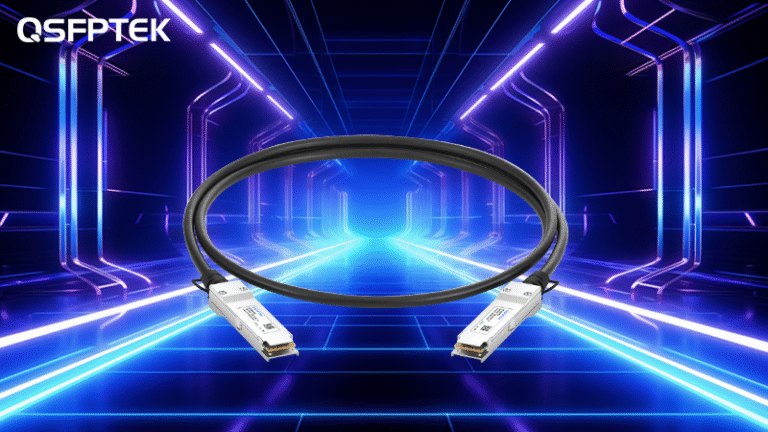For short-distance, high-speed networking, 100G QSFP28 DAC modules have become indispensable. Direct Attach Copper (DAC) cables offer a cost-effective, low-latency, and energy-efficient way to connect switches, routers, and servers in data centers. By combining plug-and-play simplicity with 100G throughput, DAC solutions are widely deployed in modern network fabrics.
How QSFP28 DAC Works
A QSFP28 DAC is essentially a twinax copper cable with integrated transceivers on each end. Each cable supports four 25G lanes, achieving a full 100G link. Unlike optical transceivers, DAC modules do not require fiber, lasers, or optical receivers. This makes them cheaper, simpler, and highly reliable for short runs, typically up to 5–7 meters for passive DACs, or up to 15 meters for active DACs with signal conditioning
DAC is ideal for top-of-rack connections, server-to-switch uplinks, and switch-to-switch interconnects within the same rack or adjacent racks. The QSFP28 form factor ensures compatibility with modern 100G ports and supports hot-swapping.
Advantages of DAC
DAC modules offer low latency, high reliability, and low power consumption. There are no optical components to degrade, no need for fiber cleaning, and the cables are robust against physical damage. For dense data center environments, DAC reduces cabling complexity while providing cost-effective 100G connectivity.
Active DAC modules extend reach slightly, use signal equalization to maintain signal integrity, and are suitable for slightly longer runs without optical transceivers. Both passive and active options integrate easily into existing network architectures.
Deployment Scenarios
The Direct attach cable is particularly popular in data center topologies. Leaf-spine networks require numerous high-speed interconnects; deploying QSFP28 DACs ensures reliable 100G links without the cost and maintenance of optical modules.
Another scenario is connecting high-performance servers in clustered computing environments. DACs minimize latency, which is crucial for database clusters, virtualization-heavy workloads, and real-time applications.
Enterprises also use DACs for switch-to-switch uplinks within the same rack or between adjacent racks. The simplicity and plug-and-play nature reduce deployment time and troubleshooting effort.
Technical Considerations
DAC cables are generally limited to short distances. Passive DACs are suitable for 3–7 meters, while active DACs extend to 10–15 meters. Beyond that, optical modules are required.
Power consumption is low — often less than 1 watt per link — which helps reduce heat load in dense deployments. Cables are usually pre-terminated and tested to meet IEEE 802.3bm compliance, ensuring reliable 100G connections.
Market and Vendor Perspective
The QSFP28 DAC market has grown as data centers densified and costs became more important. Third-party vendors such as QSFPTEK provide certified DACs compatible with major switch brands, helping reduce procurement costs. DAC adoption is particularly strong in hyperscale, enterprise, and co-location data centers where high-speed short-range interconnects dominate.
Future Outlook
While optical solutions are necessary for longer runs, DAC remains critical for high-density, short-distance connections. As 400G and 800G networks emerge, DAC will continue to play a role in connecting servers and switches where distance is short and latency is a concern.
Conclusion
100G QSFP28 DAC modules provide an economical, low-latency solution for short-distance, high-speed connectivity. Their simplicity, reliability, and low power consumption make them a staple in modern data centers. For any scenario where 100G links must be established within or between racks, DAC modules offer a practical, proven solution.
